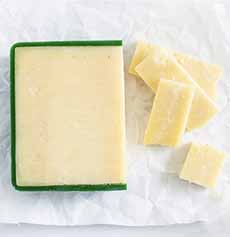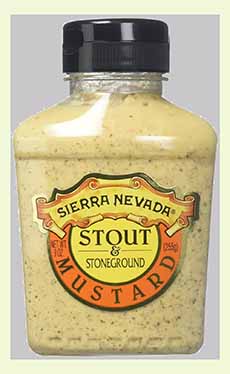Irish Cheeseburger Recipe For St. Patrick’s Day
|
If there’s a 5 Napkin Burger near you, now’s the time to grab a limited-edition Blarney Burger (photo #1). It’s one of our favorites of their seasonal burgers, and we’ll enjoy it several times before the St. Patrick’s Day holiday is over—along with their delicious sweet potato pies, pickles, and an IPA. If that sounds good, you can easily make this St. Pat’s treat at home. Five Napkin Burger calls it their “Blarney Burger”—and believe us, you don’t need any blarney* to convince us to have another. > The history of St. Patrick’s Day. > 100+ St. Patrick’s Day recipes. 1. COOK the cheeseburgers, place on buns. 2. TOP with corned beef, then mustard, then slaw, then top bun. Skewer with toothpicks as necessary. 3. SERVE with pickles, beer, optional French fries, etc. Thanks to iGourmet for this information. The cheeses can be found online. Irish cheese making is a relatively young industry. Economic factors in centuries past dictated that most dairy production in Ireland be focused on milk and butter. By the 1900s most of Irish cheese production came from large manufacturers whose main focus was Cheddar cheese. It wasn’t until the 1970s that Ireland became known for farmhouse cheese making. Today, Ireland is ninth in cheese exportation globally. Thanks to Ireland’s naturally rich and lush pastures, Irish cheese often contains a higher level of beta-carotene. This gives the milk used to make their Cheddars and other cow’s milk cheeses a natural yellow color. Most other Cheddars, including American Cheddars, use annato, a natural orange-red dye derived from a tropical tree, to give the naturally white cheese its yellow-orange color. Today, farmhouse cheeses made in Ireland are of high quality and unique to each farm thanks to the dedication of the families that produce them. Ardrahan: Ardrahan is an award-winning semi-soft vegetarian† Irish Cheese made from pasteurized cow’s milk. Ardrahan has a pungent aroma with a buttery and complex flavor. This unique Irish Cheese is a washed rind type made by the Burns family in the lush countryside of Duhallow, County Cork in Southern Ireland. Blarney Castle: Blarney Castle is a semi-soft Irish Cheese made from cow’s milk (photo #6). Available plain or smoked, Blarney Castle is made from the milk of grass-fed cows, which gives this Irish Cheese a mild and creamy flavor similar to a young Dutch Gouda. This popular Irish Cheese is ideal for sandwiches and pairs well with fresh fruit and a glass of Sauvignon Blanc. Cashel Blue: The first Irish blue cheese, Cashel Blue (photo #7) is modeled after the great French blue, Fourme d’Ambert. Developed by the Grubb family in the 1980s, Cashel Blue, a semi-soft farmhouse cheese, is an award-winning cow’s milk product made on the Grubb family’s Beechmount Farm in Tipperary Ireland. It is named after a nearby landmark, the Rock of Cashel. This creamy tangy Irish Cheese has a pale buttery interior streaked with blue veins. Cashel Blue is wonderful in leafy green salads, with fresh fruit or spread atop a piece of French crusty bread. Cahill’s Farm Cheddar: Cahill’s Farm Irish Cheddar is an artisan cow’s milk cheese made in County Limerick in Ireland. This unique handmade Irish Cheese starts life as a tangy Irish cheddar, which is chopped into bits before aging, blended with a flavoring, then hooped, lightly pressed and aged to perfection. Cahill’s Farm Cheddar has a veined appearance due to this production method. Flavors of this Irish Cheddar include Irish Whiskey, Porter Ale, and Elderberry Wine. This vegetarian Irish Cheese makes a stunning presentation on cheese platter or when offered as an hors d’oeuvre. Dubliner: Named after the city of Dublin, Dubliner Cheese is often described as a combination of Cheddar and Parmigiano Reggiano. Dubliner is an aged cow’s milk Irish Cheese with the texture of Irish Cheddar but the flavor of Parmesan. It uses the same rennet used in Parmigiano Reggiano production, imported from Italy, married to a modified Irish Cheddar production method. Sweet and nutty, Dubliner is aged over twelve months to create a full flavored cheese that is perfect for salads or sandwiches (photo #8). Dubliner is also available flavored with Irish stout (think Guinness) which combines the caramel and bitter notes of Irish stout with the complex flavors of Dubliner Cheese. Irish Cheddar: There are many excellent brands of Irish Cheddar: Kerrygold, Shamrock, Tipperary, and Wexford to name a few. Aged Irish Cheddars have rich, sharp and strong flavors of Ireland’s lush pastures. The grass, which is rich in beta-carotene, also provides a natural yellow color color. †A vegetarian cheese means that the cheese uses plant rennet—made from cardoon thistle, artichokes, or nettles—instead of the animal rennet, made from the stomach lining of a calf, ewe, or kid. Animal rennet was traditionally been used to make cheese. Vegan cheese, on the other hand, is made with zero animal product, neither animal milk nor rennet. Instead, it can be made from soy, nuts such as cashews and macadamias, and vegetable oils, such as coconut oil. Agar, arrowroot, peas, and tapioca are other options. ‡Why a lamburger? Sheep are abundant in Ireland, for cheese, meat, and wool. More lamb is eaten than beef. |
|
|
|
|
||





 [6] Blarney Castle is a Gouda-style cheese, similar to a young Dutch Gouda cheese (photo ©
[6] Blarney Castle is a Gouda-style cheese, similar to a young Dutch Gouda cheese (photo © 
